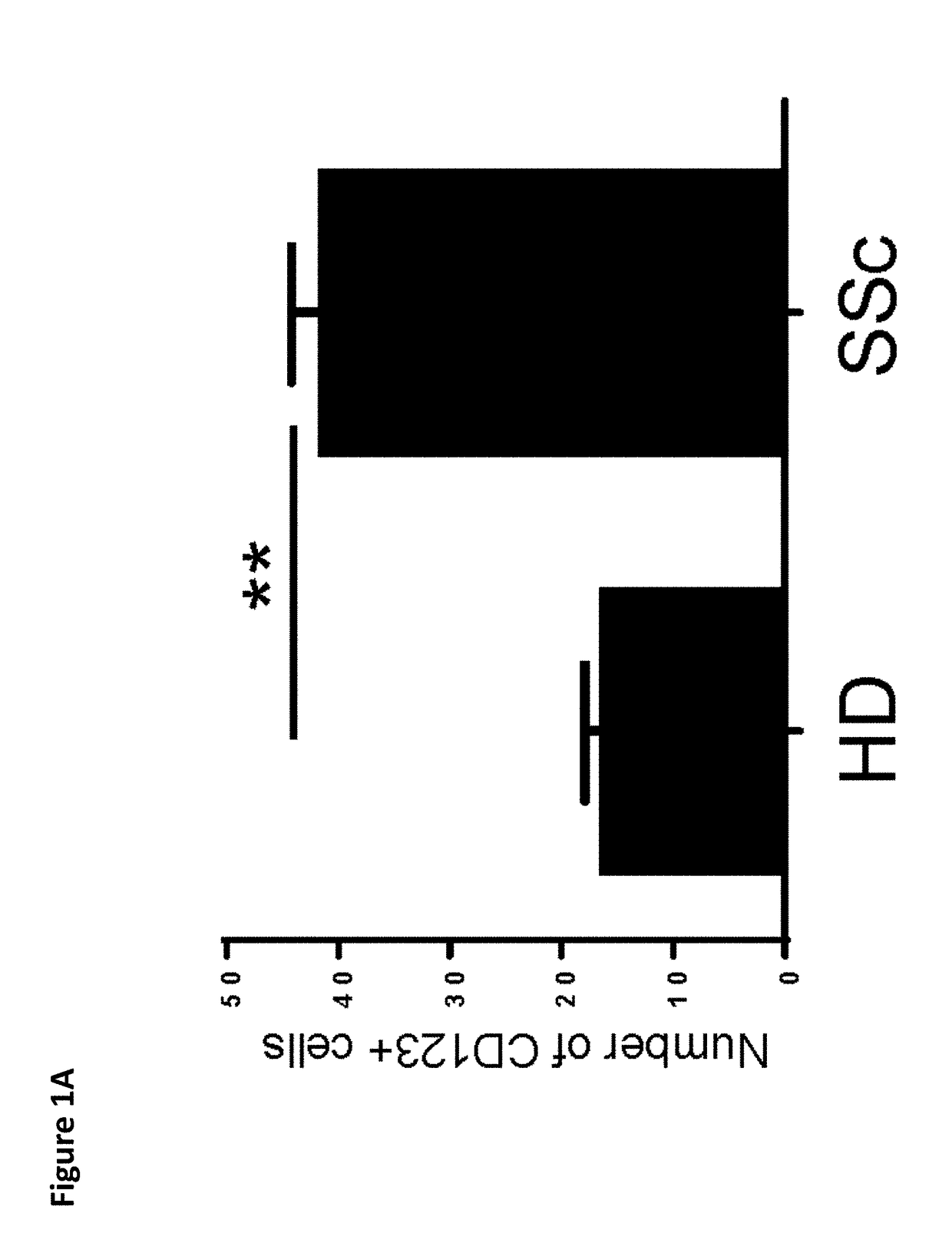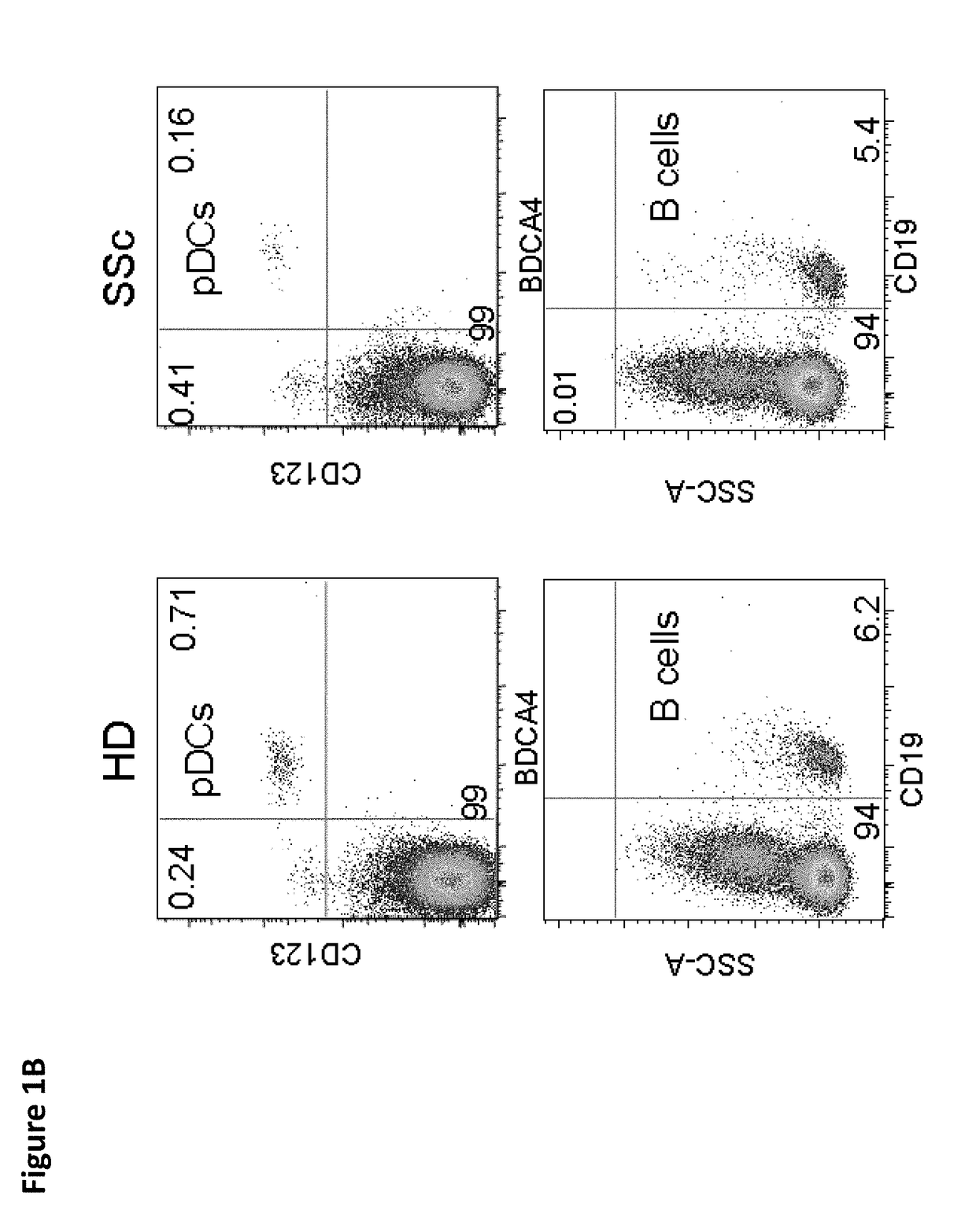Methods of treating cancer, infectious disease, and autoimmune disease using cxc chemokines
a technology of cxc chemokine and cancer, which is applied in the direction of immunological disorders, drug compositions, peptide/protein ingredients, etc., can solve the problems of blurring the boundaries between self- and non-self-discrimination of cells, and often described as negative prognosis factors, so as to increase the production of ifn-, increase the production of chemokine, and synergistic effect of ifn-
- Summary
- Abstract
- Description
- Claims
- Application Information
AI Technical Summary
Benefits of technology
Problems solved by technology
Method used
Image
Examples
example 1
and Methods
Study Design
[0202]Systemic Sclerosis (SSc) patients between 21 and 79 years of age, SLE patients between 25 and 54 years of age and healthy donors (HD) between 27 and 60 years of age were included in the human study. Patients were treated with a variety of therapies. However, they were excluded from the B cell analysis if they received rituximab, and they were excluded from the TLR assays if they were treated with hydroxychloroquine. No blinding or randomization was performed for the human studies. For in vivo studies, 8-12 week old female mice were used. Immunohistochemistry and immunostaining analyses were performed in a blinded manner.
Mice and Bleomycin Model
[0203]C57BL / 6 and C-type lectin domain family 4, member C2-diphtheria toxin receptor transgenic (CLEC4C-DTR) mice (Rowland et al. 2014) and TLR7ko mice were obtained from The Jackson Laboratory, and the TLR8Tg were generated as described (Guiducci et al. 2013). Skin fibrosis was induced using the bleomycin (BLM)-in...
example 2
ltrated the Skin of SSc Patients and were Chronically Activated with Spontaneous Secretion of CXCL4 and IFN-α
[0225]Activated pDCs have been observed to accumulate in the skin of SSc patients (van Bon et al. 2014) in a similar way to what has been observed in skin lesions in diseases characterized by interface dermatitis (Wenzel and Tuting 2008). The presence of pDCs in skin biopsies of SSc patients was observed but not in biopsies of HD (FIG. 1A), highlighting the role played by these cells in patients and confirming the importance of better understanding what controls their activation in the skin of patients. Similarly to what has been shown in lupus patients (Cederblad et al. 1998; Blanco et al. 2001), a significant (p<0.001) decrease in the number of pDCs circulating in the blood of SSc patients was found as compared to HDs (FIGS. 1B and 1C). This decrease was an indicator of in vivo activation of pDCs and their migration into peripheral lymphoid tissues and to the skin (FIG. 1A)...
example 3
SSc Patients Displayed an Aberrant Expression Profile of TLRs with the Presence of TLR8
[0226]The sensing of nucleic acids by TLRs leads to substantial production of IFN-α by pDCs, suggesting that the chronic activation of pDCs in SSc patients may involve TLRs.
[0227]Thus, the mRNA expression levels of the nucleic acid-sensing TLR7, TLR8, and TLR9, as well as TLR10 were quantified on purified pDCs from SSc patients, SLE patients or HDs. Similarly to HDs, pDCs from SSc patients expressed both BDCA2 and BDCA4, and it was confirmed that monocytes from SSc patients did not have an aberrant expression of BDCA4 (data not shown). The expression levels of TLR7, TLR9, and TLR10 were similar in PBMCs prepared from SSc patients or HDs and were equally reduced in pDC-depleted PBMCs, which is expected since these three TLRs are normally expressed on pDCs (FIG. 2A). However, it was observed that TLR8 expression was increased in PBMCs of SSc patients and surprisingly that the levels of expression of...
PUM
 Login to View More
Login to View More Abstract
Description
Claims
Application Information
 Login to View More
Login to View More - R&D
- Intellectual Property
- Life Sciences
- Materials
- Tech Scout
- Unparalleled Data Quality
- Higher Quality Content
- 60% Fewer Hallucinations
Browse by: Latest US Patents, China's latest patents, Technical Efficacy Thesaurus, Application Domain, Technology Topic, Popular Technical Reports.
© 2025 PatSnap. All rights reserved.Legal|Privacy policy|Modern Slavery Act Transparency Statement|Sitemap|About US| Contact US: help@patsnap.com



